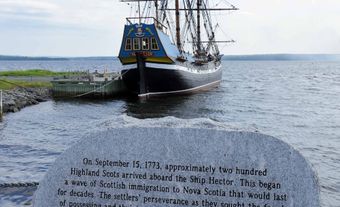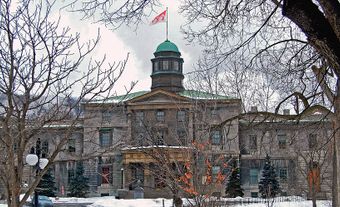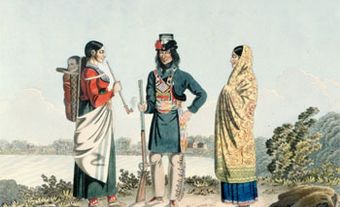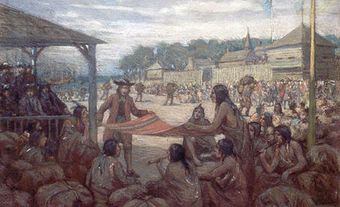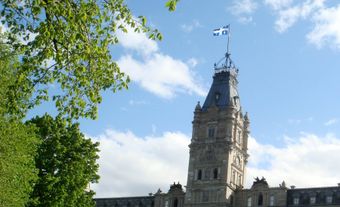James McGill, fur trader, merchant, politician, philanthropist (born 6 October 1744 in Glasgow, Scotland; died 19 December 1813 in Montreal, Lower Canada). James McGill was one of Montreal’s most prominent citizens in the 18th and early 19th centuries. He grew a successful career as a fur trader into a business empire. McGill also held various positions in public office, including three terms in Lower Canada’s legislature. His will contained the endowment for McGill University. James McGill’s achievements cannot be separated from the fact that he enslaved Black and Indigenous people and profited from this practice.

Oil on canvas by Louis Dulongpré c. 1800–10. More information on image M970X.106.
Early Life and Education
James McGill (III) was the eldest son of James McGill (II) and Margaret Gibson. His father was a metalworker whose fortunes grew during the younger James’s childhood. The family business eventually expanded into real estate. By the time McGill enrolled at the University of Glasgow in 1756, his father was a merchant, making his living from trade rather than manual labour.
University studies in McGill’s time consisted of a classical curriculum (one based on ancient Greek and Roman culture). McGill likely also studied French. His education occurred in the context of the Scottish Enlightenment. This was a period of heightened intellectual and artistic activity. McGill did not finish his degree, but he retained a value for education and the exchange of ideas.
Business Career
It is not clear when James McGill left Scotland for North America. There is a gap of about a decade in information about his life. In 1766, McGill began working in the fur trade under merchant William Grant of Quebec City. He supervised Grant’s business in the region south of the Great Lakes and ran trading enterprises of his own. McGill spent most of the next decade in the bush.
In 1775, McGill settled in Montreal and began importing goods from England to supply traders in the pays d’en haut. He remained active in the fur trade as a financier of trading expeditions. The year McGill settled in Montreal, he and several associates sent 12 canoes to Grand Portage, in what is now Minnesota. Historian Harold Innis credits this mission as “the beginning of large-scale trade to the Northwest.”
The year after he moved to Montreal, McGill married Charlotte Trottier Desrivières, a widow with two sons. Joining her large and well-connected family raised his social standing and bolstered his career.
In 1779, McGill was one of the founding shareholders of the North West Company. He left the fur-trading partnership not long after the company’s founding. He and his business partner Isaac Todd instead continued to invest in the fur trade south of the Great Lakes.
By the 1780s, McGill ran a large import and export business from Montreal, trading various products with Britain, New York and the West Indies. He also provided banking services.
James McGill’s legacy of enslavement
McGill participated in the trade of enslaved Black and Indigenous people, and he was an enslaver in his own right. He sold two enslaved Black people, named Caesar and Flora, in 1784. Three years later, he sold four enslaved people (accounts differ about whether they were Black or Indigenous). Historical records indicate that he enslaved at least five people in his own household: Marie, Marie-Louise, Jacques, Sarah, Marie-Charles (a.k.a. Charlotte, and whom some historians believe to be the same person as Sarah) and an Indigenous boy whose name is not known. McGill also profited from the trade of items produced by enslaved people in other colonies, such as molasses, rum and tobacco. Some McGill University students and faculty members have been vocal in their frustration at what they describe as the university’s refusal to confront this part of its past. (See also: Black Enslavement in Canada; Enslavement of Indigenous People in Canada.)
In the 1790s, McGill’s business activities extended to land speculation (the purchase of properties in the belief that they will grow in value) in Upper and Lower Canada. By 1810, his business interests no longer included the fur trade.
Public Office and Militia Service
James McGill was active in the public life of Montreal. He held several important appointments in municipal and provincial affairs. In 1776, he was appointed justice of the peace. This was the first of 10 appointments, which included commissions and supervisory roles on local infrastructure projects.
McGill was elected to the first session of Lower Canada’s Legislative Assembly in 1792. Around that time, the colony’s governor appointed him to its Executive Council. Voters returned him to office in 1800 and 1804. In his first two terms, he represented the Montreal riding of West Ward. In his third term, he represented East Ward. He served as the Executive Council’s temporary president in 1813.
In 1810 or 1811, McGill became a commander of Montreal’s militia (see Armed Forces). The militia was a force composed of local men who served part-time as soldiers. In this role, McGill helped organize the city’s defence during the War of 1812.
Philanthropy
When James McGill died in 1813, he was reputedly Montreal’s richest citizen. He left gifts to charities in Montreal and Glasgow, as well as 46 acres and £10,000 to endow a college or university bearing his name. McGill University, built on James McGill’s summer estate (Burnside), opened in 1829.


 Share on Facebook
Share on Facebook Share on X
Share on X Share by Email
Share by Email Share on Google Classroom
Share on Google Classroom
